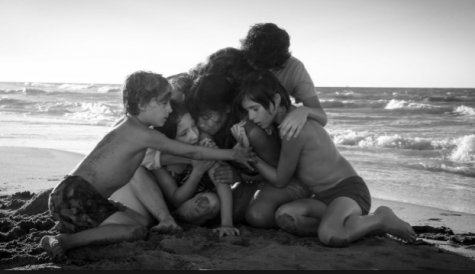‘Roma’: A story about interpersonal struggles told through intricate visuals
February 22, 2019
‘

In “Roma,” award-winning director Alfonso Cuarón carefully ties his childhood upbringing through a semi-biographical tone to the film’s plot and as a result, creates compelling visual shots that emphasize daily life and living within Mexico City during the early 70s. Through the entirety of the film, one of the most prominent connections that Cuarón makes is modeling the main character, Cleo (Yalitza Aparicio), after a woman who worked for his family and raised him.
Though Cuarón draws from his childhood experiences to voice his perspective of Roma, he decides to focus on the theme of family life instead of his individual upbringing. As a result, many of the plot’s events are centered around the average life of individuals within Mexico City and problems common to their culture and society within the 70s setting of Roma. The scope of Cuarón’s focus in the film is what makes the story line and characters stand out and the impressive visuals that follow only further emphasize the details of family life in Roma.
The film follows the life of a live-in maid of a middle-class household in the Colonia Roma neighborhood in Mexico. It centers around the main character Cleo, who must navigate through the combination of personal and societal problems and conflicts she faces on a daily basis. The household Cleo resides in contains the wife Sofia (Marina de Tavira), the husband Antonio (Fernando Grediaga), another maid named Adela (Nancy Garcia), the children (Marco Graf, Carlos Peralta, Diego Di Cort, Daniela Demesa), and the family dog. Cleo forms a relationship with a man named Fermin (Jorge Antonio Guerrero) and must face many struggles with herself as well as the family.
The story is told through a black-and-white lens accompanied by large-format digital shots that further direct attention to the changing scenes of extraordinary clarity. Taking on the wheel of colors within white and grey, the film dedicates subtle shading to bringing out the underlying details. Perhaps one the most interesting aspects of “Roma” is that information pertaining to the plot’s development is told through visual implications and suggestions as opposed to direct announcement of details. For example, the film opens with an unmoving shot that shows a stone driveway being cleaned by pouring water and a sweeping broom that is later shown to be Cleo doing chores.
The film concludes on a somber, but hopeful note after revealing new adjustments for everybody: the father Antonio moves out along with his belongings, Cleo deals with conflicting issues regarding her own moral compass, and Sophia and her family’s new life.
Another aspect of the film that Cuarón plays out is diverting focus from the actors into the characters themselves. Through selecting relatively obscure actors accompanied by the distinct visuals, Cuarón shifts the focus of the audience towards the characters and their struggles.
Cuarón is masterfully able to convey to the audience how ordinary and daily life can often be daunting and miserable in addition to the magnificent scenery and complex visual details used from scene to scene. Cuarón, known for his use of long takes in his films, again uses a variety of them in “Roma”, making the audience feel more connected to the characters and the setting.
The performance from Aparicio, who makes her film debut as Cleo, is what makes this film stand out from other dramas. Aparicio is able to convey a wide range of emotions through Cleo, in this the violent, unhealthy, and toxic city she is living in, often without saying a word. Living in a household and serving as a maid for a damaged family, along with living in a violent city with rebellions and gunshots often occurring, allows Aparicio to channel the difficulties of those who had to live in this setting.
The performances from Tavira, Grediaga, Guerrero, and the kids as minor characters are also solid, with each character dealing with an internal conflict they are struggling with. For instance, Sofia and Antonio’s damaged marriage is something that has hindered the parental figures their kids need and Fermin’s realization that he might be a father is something he is not ready for or willing to accept. With instances like these, Cuaron is able to portray character development through a plethora of characters, including the minor ones.
Boasting masterful acting, an innovative black-and-white color palette, and powerful visuals, “Roma” isn’t a film to miss.
‘Roma’
2 Hour 15 Minutes
Rated R
Directed by Alfonso Cuarón
With Yalitza Aparicio, Nancy Garcia, Diego Cortina Autrey









![A protester in a chicken suit wearing a taco hat with the words “Cluck Trump” at the “No Kings” Democracy Fair in Palo Alto on Saturday. Protestor Mary Chan said she and her husband are horrified at the state of science and medicine in America. “What he [Trump] is doing by defunding scientific research is destroying our academic medical centers, and he’s [Trump] bankrupting rural medical centers,” Chan said. “We will have lasting negative impacts on American health for decades.”](https://palyvoice.com/wp-content/uploads/2025/10/11562FFE-9912-4152-BB01-582426B52ECB_1_105_c-225x300.jpeg)